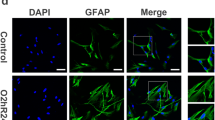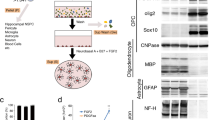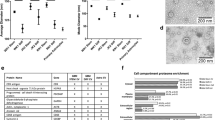Abstract
Background
Oligodendrocyte precursor cells (OPCs) can proliferate and differentiate into oligodendrocytes, the only myelin-forming cells in the central nervous system. Proliferating OPCs promotes remyelination in neurodegenerative diseases. Astrocytes (ASTs) are the most widespread cells in the brain and play a beneficial role in the proliferation of OPCs. Connexin 47 (Cx47) is the main component of AST-OPC gap junctions to regulate OPC proliferation. Nonetheless, the specific mechanism remains unclear.
Methods and results
This study investigates the proliferation mechanism of OPCs connected to ASTs via Cx47. Cx47 siRNA significantly inhibited OPCs from entering the proliferation cycle. Transcriptome sequencing of OPCs and gene ontology enrichment analysis revealed that ASTs enhanced the exosome secretion by OPCs via Cx47. Transmission electron microscopy, Western blot, and nanoparticle tracking analysis indicated that the OPC proliferation was related to extracellular exosomes. Cx47 siRNA decreased the OPC proliferation and exosome secretion in AST-OPC cocultures. Exogenous exosome supplementation alleviated the inhibitory effect of Cx47 siRNA and significantly improved OPC proliferation. Mass spectrometry revealed that LAMB2 was abundant in exosomes. The administration of exogenous LAMB2 induced DNA replication in the S phase in OPCs by activating cyclin D1.
Conclusions
Collectively, ASTs induce the secretion of exosomes that carry LAMB2 by OPCs via Cx47 to upregulate cyclin D1 thereby accelerating OPC proliferation.





Similar content being viewed by others
Data availability
The data of this study are available upon reasonable request.
References
Hirtz D, Thurman DJ, Gwinn-Hardy K, Mohamed M, Chaudhuri AR, Zalutsky R (2007) How common are the “common” neurologic disorders? Neurology 68:326–337. https://doi.org/10.1212/01.wnl.0000252807.38124.a3
Gallo V, Deneen B (2014) Glial development: the crossroads of regeneration and repair in the CNS. Neuron 83:283–308. https://doi.org/10.1016/j.neuron.2014.06.010
Zawadzka M, Franklin RJ (2007) Myelin regeneration in demyelinating disorders: new developments in biology and clinical pathology. Curr Opin Neurol 20:294–298. https://doi.org/10.1097/WCO.0b013e32813aee7f
Freeman MR (2010) Specification and morphogenesis of astrocytes. Science 330:774–778. https://doi.org/10.1126/science.1190928
Stoffels JM, Hoekstra D, Franklin RJ, Baron W, Zhao C (2015) The EIIIA domain from astrocyte-derived fibronectin mediates proliferation of oligodendrocyte progenitor cells following CNS demye-lination. Glia 63:242–256. https://doi.org/10.1002/glia.22748
Nutma E, van Gent D, Amor S, Peferoen LAN (2020) Astrocyte and oligodendrocyte cross-talk in the central nervous system. Cells. https://doi.org/10.3390/cells9030600
Zhang Y, Zhang J, Navrazhina K, Argaw AT, Zameer A, Gurfein BT, Brosnan CF, John GR (2010) TGFbeta1 induces Jagged1 expression in astrocytes via ALK5 and Smad3 and regulates the balance between oligodendrocyte progenitor proliferation and differentiation. Glia 58:964–974. https://doi.org/10.1002/glia.20978
Kleopa KA, Sargiannidou I (2015) Connexins, gap junctions and peripheral neuropathy. Neurosci Lett 596:27–32. https://doi.org/10.1016/j.neulet.2014.10.033
Nualart-Marti A, Solsona C, Fields RD (2013) Gap junction communication in myelinating glia. Biochim Biophys Acta 1828:69–78. https://doi.org/10.1016/j.bbamem.2012.01.024
Masaki K, Suzuki SO, Matsushita T, Yonekawa T, Matsuoka T, Isobe N, Motomura K, Wu XM, Tabira T, Iwaki T, Kira J (2012) Extensive loss of connexins in Balo’s disease: evidence for an auto-antibody-independent astrocytopathy via impaired astrocyte-oligodendrocyte/myelin interaction. Acta Neuropathol 123:887–900. https://doi.org/10.1007/s00401-012-0972-x
Mozafari S, Deboux C, Laterza C, Ehrlich M, Kuhlmann T, Martino G, Baron-Van Evercooren A (2021) Beneficial contribution of induced pluripotent stem cell-progeny to Connexin 47 dynamics during demyelination-remyelination. Glia 69:1094–1109. https://doi.org/10.1002/glia.23950
Fasciani I, Pluta P, Gonzalez-Nieto D, Martinez-Montero P, Molano J, Paino CL, Millet O, Barrio LC (2018) Directional coupling of oligodendrocyte connexin-47 and astrocyte connexin-43 gap junctions. Glia 66:2340–2352. https://doi.org/10.1002/glia.23471
Odermatt B, Wellershaus K, Wallraff A, Seifert G, Degen J, Euwens C, Fuss B, Bussow H, Schilling K, Steinhauser C, Willecke K (2003) Connexin 47 (Cx47)-deficient mice with enhanced green fluorescent protein reporter gene reveal predominant oligodendrocytic expression of Cx47 and display vacuolized myelin in the CNS. J Neurosci 23:4549–4559. https://doi.org/10.1523/JNEUROSCI.23-11-04549.2003
May D, Tress O, Seifert G, Willecke K (2013) Connexin47 protein phosphorylation and stability in oligodendrocytes depend on expression of Connexin43 protein in astrocytes. J Neurosci 33:7985–7996. https://doi.org/10.1523/JNEUROSCI.5874-12.2013
Li X, Penes M, Odermatt B, Willecke K, Nagy JI (2008) Ablation of Cx47 in transgenic mice leads to the loss of MUPP1, ZONAB and multiple connexins at oligodendrocyte-astrocyte gap junctions. Eur J Neurosci 28:1503–1517. https://doi.org/10.1016/j.neuroscience.2004.03.063
Liu Z, Xu D, Wang S, Chen Y, Li Z, Gao X, Jiang L, Tang Y, Peng Y (2017) Astrocytes induce proliferation of oligodendrocyte progenitor cells via connexin 47-mediated activation of the ERK/Id4 pathway. Cell Cycle 16:714–722. https://doi.org/10.1080/15384101.2017.1295183
Hill AF (2019) Extracellular vesicles and neurodegenerative diseases. J Neurosci 39:9269–9273. https://doi.org/10.1523/JNEUROSCI.0147-18.2019
McCarthy KD, de Vellis J (1980) Preparation of separate astroglial and oligodendroglial cell cultures from rat cerebral tissue. J Cell Biol 85:890–902. https://doi.org/10.1083/jcb.85.3.890
Niu J, Wang L, Liu S, Li C, Kong J, Shen HY, Xiao L (2012) An efficient and economical culture approach for the enrichment of purified oligodendrocyte progenitor cells. J Neurosci Methods 209:241–249. https://doi.org/10.1016/j.jneumeth.2012.05.032
Chen Y, Balasubramaniyan V, Peng J, Hurlock EC, Tallquist M, Li J, Lu QR (2007) Isolation and culture of rat and mouse oligodendrocyte precursor cells. Nat Protoc 2:1044–1051. https://doi.org/10.1038/nprot.2007.149
Thery C, Amigorena S, Raposo G, Clayton A (2006) Isolation and characterization of exosomes from cell culture supernatants and biological fluids. Curr Protoc Cell Biol 3:22. https://doi.org/10.1002/0471143030.cb0322s30
Mathieu PA, Almeira Gubiani MF, Rodriguez D, Gomez Pinto LI, Calcagno ML, Adamo AM (2019) Demyelination-remyelination in the central nervous system: ligand-dependent participation of the notch signaling pathway. Toxicol Sci. https://doi.org/10.1093/toxsci/kfz130
Simon C, Gotz M, Dimou L (2011) Progenitors in the adult cerebral cortex: cell cycle properties and regulation by physiological stimuli and injury. Glia 59:869–881. https://doi.org/10.1002/glia.21156
Levine JM, Reynolds R, Fawcett JW (2001) The oligodendrocyte precursor cell in health and disease. Trends Neurosci 24(1):39–47. https://doi.org/10.1016/s0166-2236(00)01691-x
Traiffort E, Kassoussi A, Zahaf A, Laouarem Y (2020) Astrocytes and microglia as major players of myelin production in normal and pathological conditions. Front Cell Neurosci 14:79. https://doi.org/10.3389/fncel.2020.00079
Arai K, Lo EH (2010) Astrocytes protect oligodendrocyte precursor cells via MEK/ERK and PI3K/Akt signaling. J Neurosci Res 88:758–763. https://doi.org/10.1002/jnr.22256
Garwood J, Garcion E, Dobbertin A, Heck N, Calco V, ffrench-Constant C, Faissner A (2004) The extracellular matrix glycoprotein Tenascin-C is expressed by oligodendrocyte precursor cells and required for the regulation of maturation rate, survival and responsiveness to platelet-derived growth factor. Eur J Neurosci 20:2524–2540. https://doi.org/10.1111/j.1460-9568.2004.03727.x
Gumbiner BM (1996) Cell adhesion: the molecular basis of tissue architecture and morphogenesis. Cell 84:345–357. https://doi.org/10.1016/s0092-8674(00)81279-9
Garcia MA, Nelson WJ, Chavez N (2018) Cell-cell junctions organize structural and signaling networks. Cold Spring Harb Perspect Biol. https://doi.org/10.1101/cshperspect.a029181
Shamloo A, Sarmadi M (2016) Investigation of the adhesive characteristics of polymer-protein systems through molecular dynamics simulation and their relation to cell adhesion and proliferation. Integr Biol (Camb) 8:1276–1295. https://doi.org/10.1039/c6ib00159a
Totland MZ, Rasmussen NL, Knudsen LM, Leithe E (2020) Regulation of gap junction intercellular communication by connexin ubiquitination: physiological and pathophysiological implications. Cell Mol Life Sci 77:573–591. https://doi.org/10.1007/s00018-019-03285-0
Basu R, Das Sarma J (2018) Connexin 43/47 channels are important for astrocyte/oligodendrocyte cross-talk in myelination and demyelination. J Biosci 43:1055–1068. https://doi.org/10.1007/s12038-018-9811-0
Wasseff SK, Scherer SS (2011) Cx32 and Cx47 mediate oligodendrocyte: astrocyte and oligodendrocyte: oligodendrocyte gap junction coupling. Neurobiol Dis 42:506–513. https://doi.org/10.1016/j.nbd.2011.03.003
Orthmann-Murphy JL, Freidin M, Fischer E, Scherer SS, Abrams CK (2007) Two distinct heterotypic channels mediate gap junction coupling between astrocyte and oligodendrocyte connexins. J Neurosci 27:13949–13957. https://doi.org/10.1523/JNEUROSCI.3395-07.2007
Li H, Tang M, Liang H, Li Y, Wang J, Song Y, Zheng Y, Xi J, Zhang J, Hescheler J, Zhu M (2013) Coculture of embryonic ventricular myocytes and mouse embryonic stem cell enhance intercellular signaling by upregulation of connexin43. Cell Physiol Biochem 32:53–63. https://doi.org/10.1159/000350124
Yao J, Morioka T, Oite T (2000) PDGF regulates gap junction communication and connexin43 phosphorylation by PI 3-kinase in mesangial cells. Kidney Int 57:1915–1926. https://doi.org/10.1046/j.1523-1755.2000.00041.x
Chen M, Liu Y, Yi D, Wei L, Li Y, Zhang L (2014) Tanshinone IIA promotes pulmonary artery smooth muscle cell apoptosis in vitro by inhibiting the JAK2/STAT3 signaling pathway. Cell Physiol Biochem 33:1130–1138. https://doi.org/10.1159/000358682
Xu D, Liu Z, Wang S, Peng Y, Sun X (2017) Astrocytes regulate the expression of Sp1R3 on oligodendrocyte progenitor cells through Cx47 and promote their proliferation. Biochem Biophys Res Commun 490:670–675. https://doi.org/10.1016/j.bbrc.2017.06.099
Caby MP, Lankar D, Vincendeau-Scherrer C, Raposo G, Bonnerot C (2005) Exosomal-like vesicles are present in human blood plasma. Int Immunol 17:879–887. https://doi.org/10.1093/intimm/dxh267
Admyre C, Johansson SM, Qazi KR, Filen JJ, Lahesmaa R, Norman M, Neve EP, Scheynius A, Gabrielsson S (2007) Exosomes with immune modulatory features are present in human breast milk. J Immunol 179:1969–1978. https://doi.org/10.4049/jimmunol.179.3.1969
Simons M, Raposo G (2009) Exosomes–vesicular carriers for intercellular communication. Curr Opin Cell Biol 21:575–581. https://doi.org/10.1016/j.ceb.2009.03.007
Li R, Wang Y, Zhang X, Feng M, Ma J, Li J, Yang X, Fang F, Xia Q, Zhang Z, Shang M, Jiang S (2019) Exosome-mediated secretion of LOXL4 promotes hepatocellular carcinoma cell invasion and metastasis. Mol Cancer 18:18. https://doi.org/10.1186/s12943-019-0948-8
Aumailley M (2013) The laminin family. Cell Adhes Migr 7:48–55. https://doi.org/10.4161/cam.22826
Yao Y (2017) Laminin: loss-of-function studies. Cell Mol Life Sci 74(6):1095–1115. https://doi.org/10.1007/s00018-016-2381-0
Funding
This study was supported by the Natural Science Foundation of China (NSFC 82171522) and the Chongqing Science and Technology Commission (No. cstc2019jcyj-msxmX0193).
Author information
Authors and Affiliations
Contributions
NC made a key contribution to the experimental design, data analysis, and manuscript draft. YX and WZ participated in the experimental process. XW, ZS, LZ, and HW provided intellectual content. YT and YP guided the whole study and revised the manuscript. All authors approved the final manuscript.
Corresponding authors
Ethics declarations
Conflict of interest
The authors have no relevant financial or non-financial interests to disclose.
Ethical approval
Experimental animals in this study were provided by the Experimental Animal Center of Chongqing Medical University (Animal Use Approval No. SYXK YU 2018-0003). All animal experiments were approved by the Committee for Ethics in Animal Experimentation of Chongqing Medical University.
Consent to participate
Not applicable.
Consent to publication
Not applicable.
Additional information
Publisher's Note
Springer Nature remains neutral with regard to jurisdictional claims in published maps and institutional affiliations.
Supplementary Information
Below is the link to the electronic supplementary material.
Rights and permissions
About this article
Cite this article
Cheng, N., Xiong, Y., Zhang, W. et al. Astrocytes promote the proliferation of oligodendrocyte precursor cells through connexin 47-mediated LAMB2 secretion in exosomes. Mol Biol Rep 49, 7263–7273 (2022). https://doi.org/10.1007/s11033-022-07508-9
Received:
Accepted:
Published:
Issue Date:
DOI: https://doi.org/10.1007/s11033-022-07508-9




